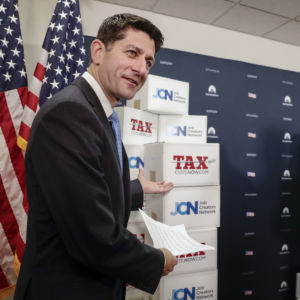A fairly explicit goal of the Republican tax proposal was to punish states like New York and California, which vote overwhelmingly Democratic in national elections. These states also have relatively high state and local taxes since they try to provide good services to their residents.
This means they spend more money on education, both K-12 and university level, they have better state Medicaid benefits, and they have a more generous safety net for the poor. As a result, most blue states tend to have higher income and property taxes than many reliably red states, like Alabama and Louisiana.
The new Republican tax plan punishes blue states for maintaining high levels of public services by severely limiting the amount of state and local taxes that can be taken as deductions against federal income tax. While previously there was no limit on the deduction, with the idea that if people are paying money as taxes already, they should not be taxed on this money again. However, the new Republican tax plan puts a $10,000 cap on the amount of state and local taxes that can be deducted.
While most people will not hit this cap, in higher tax states, upper middle-class people can easily be far over this limit. For example, it is entirely plausible that a person with a $200,000 a year income, would face a property tax bill in the range of $8,000 to $10,000 a year in New York or California. Given their income tax structures, this person may pay in the neighborhood of $10,000 a year in state income taxes.
Since most or all of their $10,000 is taken up by their property tax bill, this person will not be able to deduct most of their state income tax from their federal income taxes. In that case, they could be looking at an increase in their income taxes in the range of $2,000 to $3,000. For higher-income people the hit from the tax plan will be even more.
While the people looking at big tax increases are mostly among those who have benefited from the upward redistribution of wealth over the last four decades, many are not especially well off. But perhaps more important, these are people with substantial political power.
If higher-income residents can no longer deduct their state taxes, thereby effectively losing a federal subsidy, they will pressure state governments to cut their taxes. If that happens, blue states will lose revenue and be forced to cut back services.
Employer-side payroll taxes provide a way around this problem. Insofar as these taxes substitute for state income taxes, they will effectively allow individuals to continue to benefit from a federal income tax deduction.
Take the example of the person earning $200,000 a year. Suppose that instead of paying a state income tax of $10,000, her employer was required to pay a 5 percent payroll tax on this worker’s wages. Typically, we expect that this money will come out of the worker’s paycheck, since employers don’t care if they have to pay money to a worker or to the government as a tax on the worker’s wages.
That would mean that the worker’s pay would fall by $10,000 to $190,000. This fall in wages may not happen all at once and may not occur for every worker, but if it does it leaves the worker in the same place with regard to their state taxes. Previously they had gotten $200,000 in pay, but had to pay $10,000 in state income taxes, leaving them with $190,000. Now they are getting paid $190,000 but they don’t owe any state income tax on this money.
While the worker is in the same spot relative to the state government, with the payroll tax they will owe less federal income tax. Instead of paying income taxes on $200,000 of wage income, they will be taxed only on $190,000. In effect, switching to a payroll tax preserves the deduction, or most of it, for state and local taxes.
States should not be in the business of gaming the federal tax code. However, when the federal government designs the tax code explicitly designed to hurt certain states, it is entirely appropriate for them to fight back. This little tax trick is a great way to hit Trump and the Republicans and preserve the quality of state services in more liberal states.

